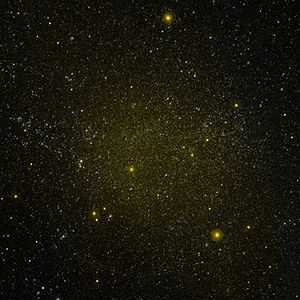Fornax Dwarf
| Fornax Dwarf Spheroidal | |
|---|---|
|
The Fornax dwarf galaxy. Credit: ESO/Digitized Sky Survey 2 | |
| Observation data (J2000 epoch) | |
| Constellation | Fornax |
| Right ascension | 02h 39m 59.3s[1] |
| Declination | −34° 26′ 57″[1] |
| Redshift | 53 ± 9 km/s[1] |
| Distance | 460 ± 30 kly (140 ± 10 kpc)[2][3] |
| Type | dE0[1] |
| Apparent dimensions (V) | 17′.0 × 12′.6[1] |
| Apparent magnitude (V) | 9.3[1] |
| Notable features | has 6 globular clusters |
| Other designations | |
| Fornax dSph,[4] Fornax Dwarf Elliptical,[4] Fornax Dwarf Galaxy,[4] Fornax dE,[4] PGC 10074 / 10093[1] | |
The Fornax Dwarf Spheroidal is an elliptical dwarf galaxy in the constellation Fornax that was discovered in 1938 by Harlow Shapley. He discovered it while he was in South Africa on photographic plates taken by the 24 inch Bruce refractor at Boyden Observatory, shortly after he discovered the Sculptor Dwarf galaxy.
The galaxy is a satellite of the Milky Way and contains six globular clusters; the largest, NGC 1049, was discovered before the galaxy itself. The galaxy is also receding from the Milky Way at 53 km/s. It mostly contains population II stars.
Globular clusters
Using the Hubble Space Telescope, scientists derived a color-magnitude diagram for Fornax 4, a globular cluster within this galaxy. Unlike the globular clusters Fornax 1, 2, 3, and 5, which have horizontal branches across a wide range of colors and include RR Lyrae variables, Fornax 4 is found to have only red in its horizontal branch. Fornax 4 is also ~3 Gyr younger than the other globular clusters. The color-magnitude diagram of Fornax 4 has a strong similarity to "young" galactic globular Ruprecht 106.[5]
This leads to two open questions: Why do dwarf spheroidals allow the formation of globular clusters like Fornax 4 and Terzan 7 (of Sagittarius dwarf) long after globular clusters ceased to form in the main body of the Galactic halo? Is it possible that "young" globular clusters of the outer halo like Ruprecht 106 were originally formed in now defunct dwarf spheroidals?[6]
Gallery
External links
- Fornax dSph
- Fornax Dwarf
- The Fornax Dwarf on WikiSky: DSS2, SDSS, GALEX, IRAS, Hydrogen α, X-Ray, Astrophoto, Sky Map, Articles and images
References
- ↑ 1.0 1.1 1.2 1.3 1.4 1.5 1.6 "NASA/IPAC Extragalactic Database". Results for Fornax Dwarf Spheroidal. Retrieved 2006-11-29.
- ↑ I. D. Karachentsev, V. E. Karachentseva, W. K. Hutchmeier, D. I. Makarov (2004). "A Catalog of Neighboring Galaxies". Astronomical Journal 127 (4): 2031–2068. Bibcode:2004AJ....127.2031K. doi:10.1086/382905.
- ↑ Karachentsev, I. D.; Kashibadze, O. G. (2006). "Masses of the local group and of the M81 group estimated from distortions in the local velocity field". Astrophysics 49 (1): 3–18. Bibcode:2006Ap.....49....3K. doi:10.1007/s10511-006-0002-6.
- ↑ 4.0 4.1 4.2 4.3 "SIMBAD Astronomical Database". Results for Fornax Dwarf Spheroidal. Retrieved 2006-11-29.
- ↑ Buonanno, R. et al. (1 October 1999). "HST photometry of the fornax dSph galaxy: cluster 4 and its field". The Astronomical Journal 118: 1671-1683. arXiv:astro-ph/9907073.
- ↑ van den Bergh, Sidney (April 2000). "Updated Information on the Local Group". The Publications of the Astronomical Society of the Pacific 112 (770): 529–536. arXiv:astro-ph/0001040. Bibcode:2000PASP..112..529V. doi:10.1086/316548.
| |||||||||||||||||||||||||||||||||||||||||||
Coordinates: ![]() 02h 39m 59.3s, −34° 26′ 57″
02h 39m 59.3s, −34° 26′ 57″


